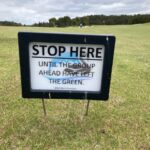
27 Oct Call-Up Holes
I’d like to focus on one aspect of Member Standards – our two Call-Up Holes, and the behaviour and respect for other Members that is expected when playing these holes.
We have two call-up holes at MRGC. They are our long par 3’s, the 8th and the 16th. And let me start by congratulating Members – overall the Call-Up procedures are working very well. There were some changes made to the Call-Up signs a couple of months ago however, and I do occasionally talk to Members who are not quite familiar with the right procedures to follow, so I’ve decided to put a full explainer so that everyone knows exactly how it should work!
Why do golf courses use Call-Up Holes?
Call-up holes are used on Member golf courses to speed up overall play. They are generally used in only one specific instance – long par 3’s. (As a side-note, on Professional Tours they tend to be used on driveable par 4’s). Interestingly, for our Membership, the easiest way to think about 8 and 16 is actually as driveable par 4’s! This is because only about 10% of tee shots on 8, and about 20% of tee shots on 16 actually find the putting surface. This is what makes them such good candidates to be Call-Up Holes.
How do Call-Up Holes speed up play?
Quite simply they allow two things to happen at once. The group on the green is able to putt out at the same time that the following group is making the long-ish walk or drive up towards their tee shots.

What are the Rules for the Call-Up Holes at MRGC?
1. As a principle, you should always be looking to call up the group behind you on 8 and 16.
2. There are only two instances in which you should not Call-Up:
a. If your group has all 4 balls on the green and the group behind you have not yet reached the tee, then you should simply commence putting.
b. If your group has LOST TOUCH with the group in front. This means that you are well out of position in the field, eg a hole behind. In this very rare instance, your priority should be to catch up to the group in front. (Note – we previously had a rule in place whereby you would not Call-Up if the group in front had left the next tee. This has changed. The old rule proved to be ineffective because as soon as one group did not Call-Up, then there would be a cascade effect through the field whereby the group in front had always left the next tee, meaning that the following groups would then not Call-Up).
3. How to Call-Up safely
a. Once all four balls are either on the green or close enough to putt, signal the group behind by waving a club above your head. The group behind should then acknowledge this by also waving a club overhead.
b. The group on the green must then stand in a safe area – generally at the back of the green, and ideally on the opposite side of the green to the pin. Players should then closely watch the flight of incoming balls to avoid any risk of being struck by a ball.
c. Once all four balls have been struck, the players on the green should commence putting.
4. Called Up players
a. If you are Called-Up, please do not decline the Call-Up. Some groups have been noticed doing this, and they are perhaps not aware of the implications of this action. If a group fails to play up when Called, then this has a significant cascading effect on the field behind you. This happens because the next group arriving behind you will likely arrive either whilst you are still on the tee, or not long after you have hit, and they will expect to be Called-Up. By the time you reach the green and then Call-Up this group, the group ahead of you will have opened up a very significant gap, and you have also slowed down the entire field behind you.
b. Assume that you will be Called-Up on these holes, and therefore be ready to acknowledge the signal and to hit right away.
c. Once you have all teed off, start walking or driving towards the green and then do not proceed past the “STOP HERE” signs positioned in the fairway and beside the cart path. Waiting at these signs respects the right of the players in front to putt out without having carts or other players approaching the green.
d. If a following group or individual inadvertently passes the signs, players on the green should politely ask the following group or individual to return to the nearest marked sign.
Should I Call-Up on any other holes?
Calling-Up on any holes other than 8 and 16 is entirely at your discretion. A scenario where it sometimes makes sense to do so is on 12. This hole occasionally causes play to back up, so if you find yourself on 12 with groups stacked up both in front of you and behind, Calling-Up here can help to clear the backlog.
Thanks to all Members for their cooperation with this, and the respect that they are showing for their fellow Members when they follow the Call-Up directions.
 Andy Meldrum
Andy Meldrum
MRGC Club Captain


